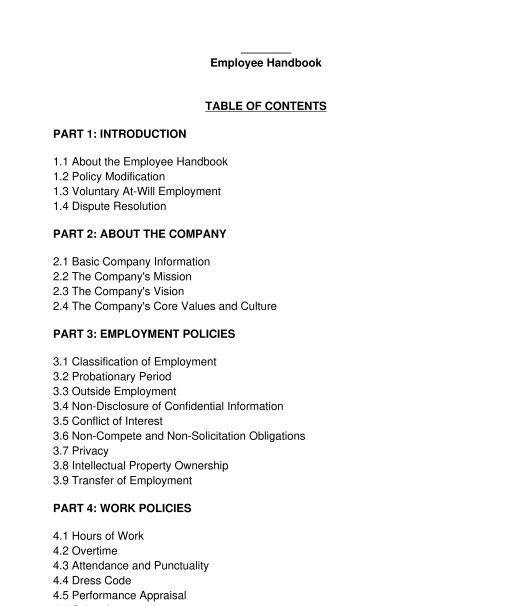 09/09/2025
09/09/2025

Answer a few questions and your document is created automatically.

Your document is ready! You will receive it in Word and PDF formats. You will be able to modify it.

 09/09/2025
09/09/2025
 Word and PDF
Word and PDF
 16 to 23 pages
16 to 23 pages



An employee handbook also known as a staff manual outlines the rights and benefits of employees, the organization's culture and objectives, disciplinary measures and procedures for handling and resolving disputes, work policies, and employment policies. Hence, it is a compilation of all the information regarding an employer's policies and procedures.
The employee handbook is useful for both new and current employees as it informs them about the rules, regulations, and expectations of the organization regarding their employment and job performance.
The employee handbook provides guidelines for employees, outlining the organization's policies, procedures, and expectations. It serves as a reference for employees to understand the company's rules, benefits, and general conduct expected within the workplace.
On the other hand, the Employment Contract is a legally binding contract between an employer and an individual employee. It specifies the terms and conditions of employment, such as salary, job responsibilities, work hours, duration of employment, and conditions for termination.
Hence, while the employment contract is specific to an individual employee, the employee handbook provides general guidelines for all employees and the employer.
No, the employee handbook is not mandatory in Nigeria. However, employers should have an employee handbook as it provides employees with a clear understanding of their rights, responsibilities, and the employer's expectations.
The employee handbook usually contains information about the employer's work policies, including the following:
Employers are prohibited from implementing a policy that denies female workers paid maternity leave, as this is a mandatory provision.
Similarly, employers cannot implement a policy that allows them to terminate their employees without providing proper notice or salary instead of notice.
When terminating or dismissing an employee from work, employers are required by law to either provide adequate notice or salary in lieu of notice. The notice period is often determined by the employment contract. However, many organizations prefer one-month notice. On the other hand, employers can provide an advance salary in place of notice. When this is done, there is no need for notice.
The main parties involved in an employee handbook are the employer and the employees.
The employer is an individual, company, or other registered organization that employs individuals to do work for wages or salary and will be implementing the employee handbook.
The employee is an individual who is employed by the employer and is required to comply with the policies and procedures outlined in the employee handbook.
An employee handbook does not have a fixed duration. It remains in effect until it is revised or replaced.
Organizations usually review and update the handbook to reflect changes in laws and company policies. After this, employers notify their employees about recent changes in the employee handbook.
After the employee handbook is ready the employer should provide copies to all employees, either in print or electronically. In the same vein, employees can provide a link where employees can have access to the employee handbook electronically.
After this, the employees should sign an acknowledgment form confirming they have received, read, and understood the contents of the employee handbook. Employees can keep a copy of the employee handbook for their records or at least have access to the employee handbook (either electronically or in print) for reference purposes.
Note: When hiring a new employee, the employee handbook should be given to the new employee together with the Employment Offer Letter and/or the Employment Contract.
Other policy documents that can be attached to the employee handbook for the employee's reference are as follows:
No, it is not necessary for employee handbooks to be notarized in Nigeria.
No, employee handbooks are not registered in Nigeria.
No, it is not necessary to have witnesses for employee handbooks.
There are no costs involved in finalizing an employee handbook.
The Nigerian Labour Act 2004 is the primary legislation that regulates employment matters in Nigeria. Other laws that apply to the employee handbook are as follows:
You fill out a form. The document is created before your eyes as you respond to the questions.
At the end, you receive it in Word and PDF formats. You can modify it and reuse it.
Guides to help you
Employee Handbook - FREE - sample template
Country: Nigeria